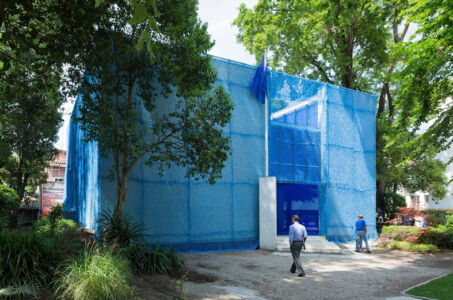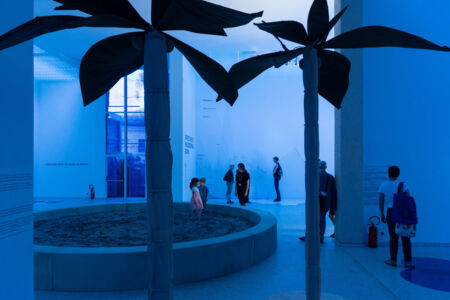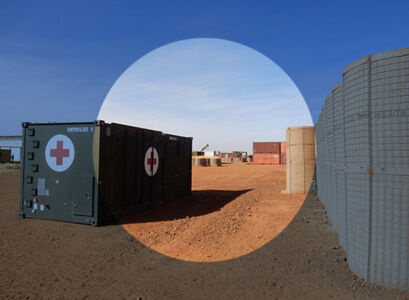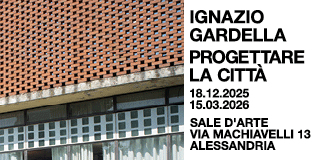Interview with the curator Malkit Shoshan
How did born the project “BLUE: Architecture of UN Peacekeeping Missions” and what will be its future development?
The project started about ten years ago with a visit to Kosovo. I have then realized the magnitude and impact of UN peacekeeping missions on the local livelihood. The peacekeeping missions introduce a new type of space to the cities. Large UN compounds were visible from every street corner. Their size and presence within the local civic space made me wonder what will happen to all these spaces once the mission is over, and if their legacy was ever taken into account. They were foreign to the local landscape, and their footprint was too big to overlook. After that trip, I began researching the evolution of UN peacekeeping missions and the possibility to introduce design thinking to the planning process of these spaces. The research turned into an ongoing conversation with the Dutch participants in UN missions, with the ministries of Defense and Foreign Affairs and with their mission to the UN. By now, I focus the research on the current mission in the Sahel with a focus on Mali. There are about nine large missions in this region and UN peacekeepers presence in more than 170 cities. If we introduce design thinking here and address the mission as an opportunity to improve the local environment that is in urgent need for resources; it is possible to elevate the lives of millions.
Architecture can be a peace mission? In what way?
After the end of the cold war and increasingly after 9/11 and the launch of the war on terror, warfare moved to the city. If we address the context of Peacekeeping missions – the front line of conflict – and use architecture and urban design to strengthen cities and the urban fabric in the Sub-Sharan Africa, we can create longer lasting stability. Improving the livelihood of people can help stabilizing this region. The scarcity of water, food and economic growth are primer reasons of perpetual conflicts. The peacekeepers have, knowledge and global capacity, they can help generating resources and working together with the local community to improve the conditions of households, neighborhoods, and cities.
Allowing access to water, to food, to medicine; Empowering the locals such that they could reconstruct their cities. Developing projects with the locals and making sure knowledge and resources remain with the community after the mission has left can generate lasting stability/peace.
Nowadays this is not the case. The UN is isolated. The only places that are light at night in these regions are the UN bases. Inside of them, there are resources and capacity, but these are surrounded by barbwire and trenches. The links between the UN and the local are very limited; if not non-existing – even though the city’s neighborhoods are very close to the UN bases. The locals are frustrated to see the global capacity in their back and front yard. This frustration cannot lead to peace; If the global community won’t address the local scarcity and won’t creating gestures toward the community the conflict will not only continue, but will escalate. With architecture, you can create spaces that allow interaction and integration of the two communities. The project introduces a different thinking about the impact and legacy of the UN base; as well as its connection to the city.
There may be a relationship between the actions of peacekeeping missions and the local identities?
There must be. The UN cannot operate in isolation. They are part of a context – of the local community; of a city. The proximity of UN bases to cities must be considered. Identity, however, is a complex issue. Each city has multiple ethnic groups, agendas, and interests. Local identity should be respected. The relations should be based on notions of equity and equality. It is the only way to develop sustainable relations between groups in society and the UN should from one hand be to emphasized these values if it wants to promote peace, and make resources available from the other.
The design can help you interpret the local identities that are already threatened by conflict without giving the perception of a new form of colonialism?
I think if development is introduced in a respectful manner. If access to resources is allowed to all groups in a balanced way, then identity is not an issue. The level of scarcity, the urgency to strengthen this community and their cities should be a priority for intervention. The project doesn’t propose to settle the nomad or to change the identity of the local. It aims at creating possibilities and choices for the locals to live in prosperity. The UN missions should not stay in a country endlessly. They should work toward implementing a post-mission situation from the very beginning.
Analyzing the architectures in the conflict’s areas have you find some ways to communicate with local stakeholders and interpret their needs?
In participatory planning processes, you don’t need an interpreter. The community should represent itself. Stake holders and users should have a say in the way their neighborhood is organized. I am not interested in translating the voice of…but in making space for different agencies and interest groups to come together – in policy and space.
Can you tell about the e-book Unmanned? How does this publication series is related with the theme of the exhibition?
The Unmanned is a publication series that captures series of presentations organized in NYC and Rotterdam around processes of the militarization of the civic space. We raise questions about the way are cities corresponds to these processes to preserve values such as privacy, communal gathering, freedom of movement and so on. The Unmanned is not directly related to BLUE. It is a format of representation, publication, of different issues and discussions along the topics I have just described.






























[…] LEGGI L’INTERVISTA IN LINGUA ORIGINALE […]